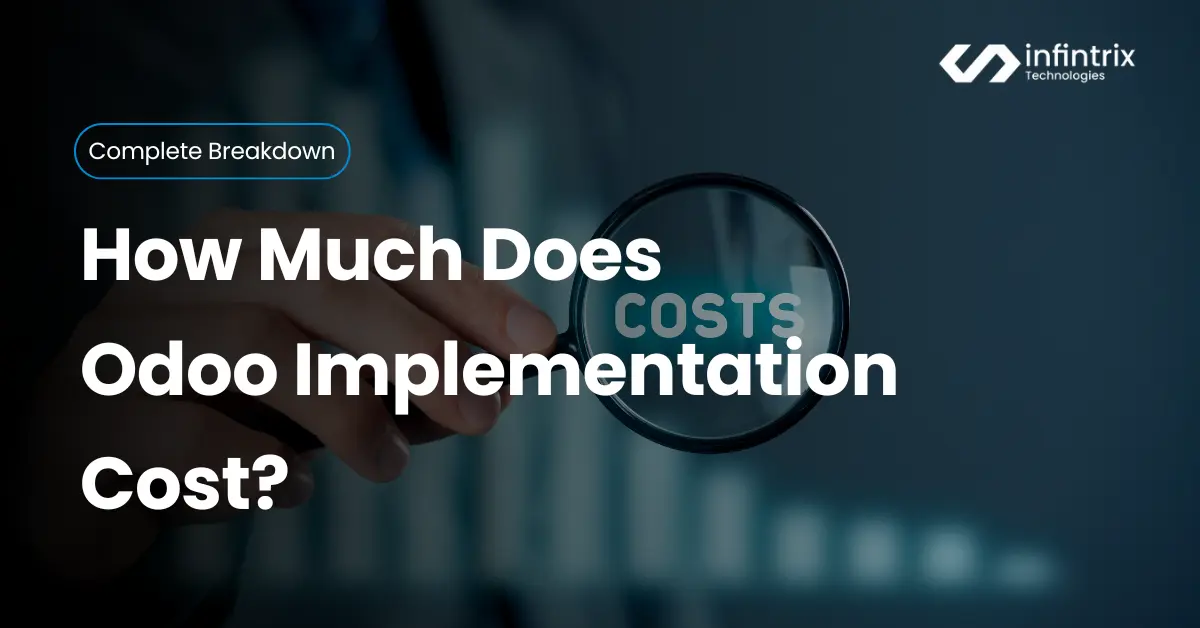In 2025, Odoo remains at the forefront of the ERP market, offering a cost-effective and flexible business management platform. Yet when companies ask, “How much does Odoo implementation cost?” the answer depends on more than just the software itself.
Every ERP implementation involves unique business processes, data, and workflows. The real question isn’t just how much it costs — it’s what drives that cost. Whether you’re a manufacturing firm in Karachi or a retail startup in Lahore, understanding this breakdown helps you plan smarter, avoid hidden expenses, and achieve long-term ROI.
Think of ERP like constructing a building — the software is your framework, but the customization, design, and craftsmanship determine the total investment. This guide explores the true Odoo implementation cost breakdown for 2025, helping you make confident, well-informed decisions for your business.
Why Odoo Implementation Costs Differ from One Business to Another
No two Odoo implementations are identical. Every company operates differently, from the number of users and modules needed to how much customization or data migration is required.
For example, a mid-sized trading company using standard accounting and inventory modules will spend far less than a manufacturer that needs advanced production planning and integration with third-party systems. The project scope, level of automation, and number of users all directly affect total implementation cost.
Main Factors That Shape the Final Implementation Cost
Here are the primary variables that influence how much you’ll invest in your ERP implementation:
- Number of users and modules – Each additional user or module adds configuration time and licensing costs.
- Community vs. Enterprise edition – Odoo Community is free but limited; Odoo Enterprise includes advanced features and official support.
- Hosting type – Whether you choose cloud (SaaS) or on-premise hosting changes both one-time and recurring costs.
- Custom module development – The more unique your workflows, the higher your customization needs and development hours.
- Data migration and integration – Importing legacy data or connecting with other systems adds technical complexity and consulting time.
Real-World Example by Industry Type
Odoo implementation costs also vary by industry due to different process needs and automation levels:
| Industry | Typical Modules | Implementation Complexity | Cost Trend (2025) |
| Manufacturing | MRP, Inventory, Accounting | High (custom workflows, integrations) | $$$ |
| Retail | POS, CRM, Inventory | Medium | $$ |
| Services | Project, HR, Accounting | Moderate | $$ |
| eCommerce | Website, CRM, Sales | Moderate | $$ |
Manufacturing and retail projects generally require more customization, making them costlier than simpler service-based setups.
What’s Included in the Odoo Implementation Cost?
When businesses receive an implementation quote, they often ask, “What exactly am I paying for?” Understanding each cost component helps you compare proposals fairly and manage your budget effectively.
Implementation costs usually cover software licensing, configuration, customization, data migration, training, and ongoing support — the full journey from setup to go-live.
Licensing and Subscription Costs
Odoo offers two editions: Community (free and open-source) and Enterprise (licensed).
Enterprise plans, which include technical support and cloud hosting, charge per-user and per-module annually.
For instance, in 2025, Odoo Enterprise licensing might range between $25–$35 per user/month, depending on modules and hosting preferences. While Odoo Community avoids subscription fees, it requires more internal or partner-led technical management.
Customization and Module Development
Every business has unique workflows. That’s why most projects include custom module development or feature tweaks to align Odoo with real operations.
Customization can account for 20–40% of total implementation cost, depending on depth. For example, developing a tailored manufacturing workflow or complex reporting dashboard adds both developer hours and testing time.
Strategic implementation partners like Infintrix Technologies often help businesses decide when customization truly adds value — and when a standard module will do the job just as well.
Integration, Data Migration, and Training
Integrating Odoo with other platforms (like CRMs, POS systems, or external accounting tools) increases overall cost, especially if third-party APIs are involved.
Data migration — importing records from Excel or older ERP systems — is another major cost driver, as it requires careful validation and cleaning.
Finally, training sessions for your team ensure proper adoption. Skipping this step often leads to inefficiencies later, even with a perfect system in place.
Odoo Implementation Options: In-House vs. Certified Partner
Once you’ve scoped your ERP needs, you’ll face a strategic decision: should you implement Odoo in-house or hire a certified Odoo implementation partner? Both approaches have their place, but the right choice depends on your internal capabilities, budget, and project complexity.
Doing It In-House – Pros and Cons
Pros:
- Lower initial cash outlay.
- Full control over configuration and testing.
- Gradual, internal skill development.
Cons:
- Requires strong technical expertise and ERP experience.
- Can lead to project delays or incomplete setups.
- Limited post-launch support and troubleshooting capacity.
In-house implementation works best for tech-savvy teams with developers already familiar with Python and Odoo frameworks.
Working with an Odoo Partner
Certified Odoo partners bring structured methodology, industry insights, and proven experience. They handle everything — from gap analysis to go-live support — ensuring faster, more reliable results.
While partner-led projects may appear costlier upfront, they often save money in the long run by reducing rework and minimizing downtime.
Companies like Infintrix Technologies specialize in transparent pricing models, guiding businesses in Pakistan and beyond through cost-effective Odoo deployments that align with real operational goals.
The Average Odoo Implementation Cost in 2025
For most businesses, the average Odoo implementation cost in 2025 depends on company size, project complexity, and the number of modules deployed. Smaller organizations can start at just a few thousand dollars, while enterprise-grade projects may reach tens of thousands due to broader integration and customization.
Here’s a general breakdown based on current market benchmarks and Odoo partner insights:
| Business Type | Modules Approx. | Cost Range (USD) | Duration |
| Small Business | 2–4 | $4,000 – $8,000 | 1–2 months |
| Mid-Size | 5–10 | $10,000 – $25,000 | 3–6 months |
| Enterprise | 10+ | $30,000 – $80,000+ | 6–12 months |
Keep in mind these are average implementation costs, not fixed prices. Customization depth, data migration volume, and training sessions can easily shift a project up or down the scale. Post-launch services like support and version upgrades also factor into the total cost of ownership (TCO).
Beyond the Basics: Hidden & Recurring Odoo Costs
Many businesses focus on initial setup pricing but forget about the recurring and hidden costs that appear later. These aren’t “extra charges” — they’re the real costs of keeping your ERP reliable, secure, and scalable.
Support, Maintenance, and Version Upgrades
Once your Odoo system goes live, you’ll need technical support and maintenance services to ensure smooth operations. Tasks like applying patches, upgrading versions, and troubleshooting bugs are ongoing responsibilities.
A good implementation partner like Infintrix Technologies typically includes these services in a managed support plan — helping businesses avoid unplanned expenses and system downtime.
Employee Training and Change Management
Even the best ERP system fails without proper user adoption. Training ensures your team understands not just how to use Odoo, but how to get value from it.
Budgeting for user training and change management upfront reduces long-term costs and ensures faster ROI. In most successful ERP projects, this investment pays back within months.
How to Estimate Your Odoo Budget More Accurately
Getting an accurate cost estimate requires more than a quick online calculator. The smartest approach is to combine business requirement analysis with a detailed project scope — outlining what you want Odoo to achieve, not just what it should do.
Here’s a simple five-step checklist to get a realistic Odoo quote in 2025:
- Define your business goals and required modules. Focus on what problems ERP should solve — such as manual reporting, disconnected systems, or stock inaccuracies.
- Choose between Odoo Community or Enterprise. Enterprise includes more features and support, while Community offers flexibility for skilled technical teams.
- Map out your integrations and data migration needs. The more systems and data you bring in, the higher the technical cost.
- Shortlist certified Odoo partners and request transparent proposals. Look for clear pricing models and defined man-hour estimates.
- Allocate funds for training, support, and version upgrades. These are essential to safeguard your investment and prevent future inefficiencies.
Infintrix Technologies, an experienced Odoo implementation partner in Pakistan, helps businesses across Lahore, Karachi, and other regions plan ERP budgets with transparency — offering phased deployment plans aligned with operational priorities.
Smart Ways to Cut Down Odoo Implementation Costs
Not every business needs a large-scale ERP rollout from day one. The most cost-effective implementations start lean and grow strategically. You can reduce expenses without compromising quality by following a few best practices.
Start with Core Modules First
Begin with critical modules like Accounting, Inventory, or CRM, depending on your pain points. Once your core processes run smoothly, expand into HR, Manufacturing, or advanced analytics. This phased approach keeps costs predictable and user adoption easier.
Use Prebuilt Apps and Community Add-ons
The Odoo Community ecosystem offers thousands of free and low-cost modules built by developers worldwide. Leveraging these ready-made tools can save time and reduce development costs by 20–30%.
Partners such as Infintrix Technologies often guide clients in choosing open-source or prebuilt solutions that balance affordability with performance — especially for small and mid-sized businesses.
FAQs on Odoo Implementation Cost (2025 Edition)
Q1: What’s the average Odoo implementation cost in 2025?
Most small to mid-sized projects range between $5,000 and $25,000, depending on modules and complexity. Infintrix Technologies’ 2025 data shows that small businesses in Pakistan often spend around $4k–$8k for basic setups.
Q2: Is Odoo free to implement?
The Odoo Community version is free, but costs arise from customization, hosting, and professional setup — especially if your business requires specific workflows or integrations.
Q3: How much does Odoo customization add to the total cost?
Custom features typically add 20–40% to the total implementation cost, depending on development scope and module complexity.
Q4: How long does a full Odoo implementation take?
Average timelines range from 1–6 months, depending on project scope. Infintrix Technologies reports that mid-sized projects typically complete in about 3–4 months with efficient planning.
Q5: What’s the most cost-effective way to start with Odoo?
Start small — implement essential modules first, then scale gradually. This phased strategy keeps budgets under control while maintaining momentum.
Final Thoughts: Focus on Long-Term Value, Not Just Cost
When planning your Odoo ERP implementation, remember — cost is only one side of the equation. The real value lies in data visibility, automation, and scalability that Odoo delivers over time.
A well-planned implementation minimizes rework, improves reporting accuracy, and connects every department under one platform. Companies that partner with experienced teams like Infintrix Technologies often find that strategic planning upfront saves far more than it costs — both in money and efficiency.

